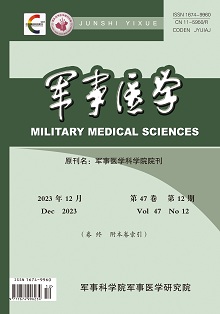Original articles
FAN Sijun, HUO Yan, GAO Weiping, LIANG Ge
Objective To study the clinical manifestations and histopathological characteristics of acute ocular injuries caused by the unsymmetrical dimethylhydrazine propellant in rabbits,and to investigate the mechanism of ocular injuries caused by unsymmetrical dimethylhydrazine. Methods A rabbit eye tainting model was established by placing propellant-grade liquid on the corneal surface. The rabbit eyes were divided into the normal control group and the 2 h,1 d,3 d and 7 d post-toxicity groups. The corneal clouding in each group was scored,the integrity of the corneal epithelium was observed,the percentage of corneal epithelial defects was calculated,fundus photographs were taken of the rabbits in each group,and the changes in the posterior segment of the retina of the rabbits were observed.Histopathological slides of rabbit eyes were prepared at each time point. Pathological sections were taken from the rabbit eyes at each time point to observe the histopathological changes of the cornea,lens,iris,ciliary body and retina.Immunohistochemistry was used to analyze the expressions of CD31,TNF-α and MMP-2 in the tissues of eyes of each group. Results The score of corneal opacity degree in each group was 0,but was 2.00 (1.25,2.50),3.00 (2.75,3.00),2.00 (2.00,2.50),1.00 (0.75,1.00) after exposure,so the difference was statistically significant (P<0.001). The percentage of the size of the epithelial defect was (100.00±0.00)% 2 hours after exposure to the toxin,but was subsequently(99.17±6.36)%,(17.38±5.66)%,and (9.71±3.00)%,respectively. The difference between the groups was statistically significant (P<0.001). Rabbits in each groups had normal fundi. Histopathological examination found that the corneal injury to the rabbits after exposure to the poison was manifested as loss of epithelia,edema and thickening of the stroma layer,cystic degeneration of epithelial cells,vasodilation and congestion of the iris and ciliary body,mild edema of the stroma layer,swelling of muscle fibers,all of which recovered within 3 days. The lens structure of the rabbits in each group remained unchanged. The expressions of MMP-2 in the cytoplasm of the corneal stroma,roots of theiris and ciliary body,and in endothelial cells in the corneal limbus vascular wall were significantly enhanced 1 day after exposure,so was the expression of CD31 in the corneal stroma and limbus. No positive expression of TNF-αwas found in anyeye tissuein these groups. Conclusion The unsymmetrical dimethylhydrazine propellant can damage eye tissues under a simulated working environment,but the damage is limited. The damage of unsymmetrical dimethylhydrazine to the cornea is superficial and confined to the corneal epithelium. The damage to the anterior segment is mild,and inflammation has a quick onset and recovery. The damage to the cornea,iris and ciliary body tends to recover on its own.
